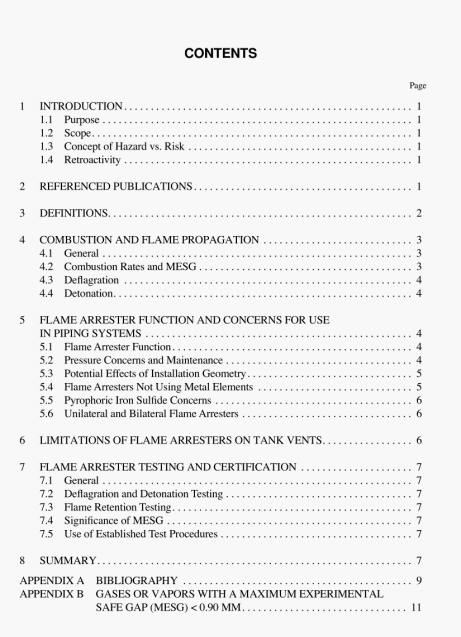API RP 2028:2002 pdf download.Flame Arresters in Piping Systems.
5.3 POTENTIAL EFFECTS OF INSTALLATION GEOMETRY
The geometry, size, and length of piping and piping systems are important to consider when selecting a flame arrester. It is possible that the level of turbulence generated by combinations of these factors may render a flame arrester incapable of quenching a flame front. Studies has noted that a correlation of the performance of a flame arrester and piping size is not always possible. It may be necessary to have tests performed for the particular size of flame arrester proposed for use. This is particularly relevant as piping diameter increases, For piping systems, it is advisable to install only flame arresters thai have been designed and tested for detonations. In some situations. this is required for regulatory compliance.
Placing two or more flame arresters in series is not advisable. It has not been demonstrated that additional protection would be provided. If the flame front propagates through the first flame arrester, it can be expected to propagate through the second flame arrester.
Pipe diameter going into and out of a flame arrester should he kept constant. Proprietary testing indicates that changes in diameter can cause flame fronts to accelerate through an arrester.
5.4 FLAME ARRESTERS NOT USING METAL ELEMENTS
Some standards and testing laboratories have provided for flame arresters that have a design that does not use metal elements. hxamples are hydraulic (water) type flame arresters in CEN-EN 12X74 and in the FM Approval Guide. The performance of these flame arresters must be demonstrated by testing.
In certain situations, the USCG regulations allow the installation of “water seals” and quick closing valves for mechanical interruption of the flame path. These devices niust meet USCG certification requirements. Demonstration of the suitability of these devices may require performance testing of the design. By contrast, emergency shutdown valves required by the USCO regulations for oil or hazardous material transfer lines and cargo vapor shutoff valves are not intended to act as flame arresters and are not required to function as quickly.
Flame arresters using devices and techniques other than metal elements are available and in use within the hydrocarbon industry.Some of these flame arresters have been in service foryears without incident; however, without proof of performanceof the design by testing, it should not be assumed that the flamearrester will be capable of performing properly. Examples offlame arresters with designs that do not use metal elements arediscussed in the following sections.
API RP 2028:2002 pdf download
